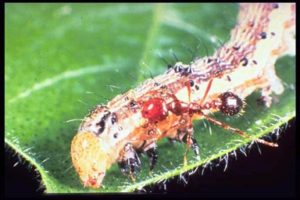Please see the update at the bottom of this article …
Every so often, I get questions about reducing fire ant mounds in reduced-tillage soybean fields, particularly from the southern counties of the state where this occurs most commonly. Fire ants enjoyed our mild winter, so I have had a couple of questions already. This insect causes problems during harvest when combines run into ant mounds, clogging or otherwise messing up the combine head and slowing down harvest. Also, operators may be stung while trying to clear the problem. There is bad news and good news, and we will start with the bad.
The bad news is there is no cheap or easy solution. Infestations can be suppressed by multiple applications of some insecticides like synthetic pyrethroids or acephate, but this is really not economically feasible, plus it can increase the risk of certain pest problems like spider mites, corn earworm, or loopers. The most effective control option is to use fire ant baits. The only bait that I’m aware of that is labeled for use in field crops is Extinguish Professional Fire Ant Bait. Like when we try to use baits for slug control, this is relatively expensive, difficult to apply, and supplies may be limited. You need a low-volume spreader to deliver 1.0-1.5 pounds per acre. Also, Extinguish is slow acting, taking several weeks to provide good control. Thus, larger mounds may still be a problem at harvest.

The good news is that fire ants are excellent predators. In soybean, they will feed on a variety of pests (including the eggs and larvae of pests). Some research in cotton indicates they are a net positive in fields because they suppress pest populations, although aphids are often worse in fields with fire ants because the fire ants feed on the honeydew and will protect aphids from other predators. After considering the options, most growers elect to live with the problem.
Update: My counterpart in Arkansas, Dr. Gus Lorenz, read this article and told me they’ve been doing trials for the last few years. He indicated that they have had good success with perimeter treatments of Extinguish, even against established infestations of fire ants. In his observations, having several rain-free days after application was key to success. They used a seeder on the four wheeler and made one pass along the edge of the field. Obviously, this would greatly reduce the costs and time of control, and we probably have a bunch of deer hunters who have seeders on 4-wheelers for establishing food plots.


I don’t have a problem with fire ants yet but do you have any advice for armadillo control? They’re becoming a big problem in my fields.
Wish I did! The holes from those half-shell little $&@# can make for a rough ride in our little small plot equipment.